Nanocellulose foam offers superior breathability, eco-friendliness, and biodegradability compared to traditional latex foam used in mattresses. Latex foam provides excellent durability and support but lacks the lightweight and moisture-wicking properties inherent in nanocellulose foam.
Table of Comparison
| Feature | Nanocellulose Foam | Latex Foam |
|---|---|---|
| Material Source | Renewable cellulose fibers from plants | Natural or synthetic latex from rubber trees |
| Durability | High tensile strength, resistant to wear | Long-lasting, resilient under pressure |
| Breathability | Superior airflow due to nanoscale pores | Good ventilation with open-cell structure |
| Comfort & Support | Excellent pressure distribution, adaptive | Responsive, offers balanced support |
| Hypoallergenic Properties | Natural resistance to dust mites and allergens | Generally hypoallergenic, may contain additives |
| Sustainability | Eco-friendly, biodegradable, low carbon footprint | Renewable but less biodegradable, variable eco-impact |
| Cost | Higher due to advanced processing | Moderate, widely available |
| Common Applications | Premium mattresses, eco-conscious bedding | Standard mattresses, pillows, cushions |
Introduction to Nanocellulose and Latex Foams
Nanocellulose foam, derived from plant-based cellulose fibers, offers exceptional breathability, lightweight structure, and high mechanical strength, making it an innovative material for mattress applications. Latex foam, sourced from natural or synthetic rubber, provides excellent elasticity, pressure relief, and durability, widely recognized for its comfort and support in bedding products. Both foams present unique characteristics; nanocellulose emphasizes sustainability and moisture regulation, whereas latex foam prioritizes resilience and hypoallergenic properties.
Material Origins and Production Processes
Nanocellulose foam is derived from plant-based cellulose fibers extracted from wood pulp, offering a sustainable and biodegradable alternative to traditional foams. The production process involves mechanical fibrillation and chemical pretreatment to create a lightweight, porous structure with high strength and breathability. Latex foam originates from natural rubber harvested from Hevea brasiliensis trees or may be synthetically produced; its manufacturing includes the Dunlop or Talalay processes, which involve whipping liquid latex into a foam and vulcanizing it for durability and elasticity.
Structural Differences Between Nanocellulose and Latex Foams
Nanocellulose foam features a highly porous, interconnected nanofiber network derived from cellulose, providing exceptional breathability and lightweight structural integrity. Latex foam consists of a denser, rubber-based matrix with a uniform cell structure that delivers durable elasticity and superior resilience. These structural differences critically influence mattress performance, with nanocellulose offering enhanced moisture management and latex prioritizing consistent support and durability.
Comfort and Support: A Comparative Analysis
Nanocellulose foam offers superior breathability and moisture-wicking properties, enhancing comfort by maintaining a cooler sleep environment compared to latex foam. Latex foam provides excellent resilience and adaptive support due to its natural elasticity, contouring closely to the body's pressure points for optimal spinal alignment. The combination of nanocellulose's lightweight structure and latex's durable firmness results in differentiated support levels, with nanocellulose foam favoring ventilation and latex foam excelling in pressure relief and durability.
Breathability and Moisture Regulation
Nanocellulose foam offers superior breathability compared to latex foam due to its highly porous nanostructure, promoting enhanced airflow throughout the mattress. This advanced material efficiently regulates moisture by absorbing and dispersing sweat, reducing heat retention and preventing the growth of mold and bacteria. Latex foam provides moderate breathability but tends to retain more moisture, making nanocellulose foam a more effective choice for temperature-neutral and hygienic sleep environments.
Durability and Longevity of Both Foams
Nanocellulose foam exhibits superior durability due to its high tensile strength and resistance to wear, maintaining structural integrity over extended periods. Latex foam offers excellent longevity with natural resilience and the ability to regain shape quickly, reducing sagging and indentations. While nanocellulose foam resists microbial growth and moisture degradation, latex foam benefits from inherent hypoallergenic properties that contribute to longer mattress life.
Environmental Impact and Sustainability
Nanocellulose foam offers superior environmental benefits compared to latex foam due to its renewable sources derived from plant fibers and biodegradability, minimizing landfill waste. Latex foam production often involves synthetic additives and chemicals, leading to higher carbon emissions and non-renewable resource consumption. Sustainable mattress choices increasingly favor nanocellulose foam for its lower ecological footprint and compatibility with eco-friendly manufacturing practices.
Allergenicity and Health Considerations
Nanocellulose foam offers superior hypoallergenic properties compared to traditional latex foam, reducing the risk of allergic reactions and respiratory issues commonly associated with natural latex. The antimicrobial nature of nanocellulose inhibits mold, dust mites, and bacteria growth, promoting a healthier sleeping environment. Latex foam may cause sensitivities in individuals allergic to natural rubber proteins, while nanocellulose provides a safer alternative for allergy-prone users.
Cost and Market Availability
Nanocellulose foam offers a sustainable alternative with higher production costs compared to latex foam, which remains more affordable and widely used in mattress manufacturing. Latex foam benefits from established supply chains and extensive market availability, making it a preferred choice for cost-sensitive consumers. Despite nanocellulose foam's limited market presence, its eco-friendly properties drive growing interest in niche sustainable mattress segments.
Choosing the Best Foam for Your Mattress
Nanocellulose foam offers superior breathability and sustainability compared to traditional latex foam, making it ideal for eco-conscious mattress buyers seeking natural materials with enhanced moisture-wicking properties. Latex foam provides durable support and excellent resilience, favored for its hypoallergenic and pressure-relief qualities suitable for sleepers with joint pain or allergies. Evaluating factors such as environmental impact, firmness preferences, and allergen sensitivity is essential when choosing the best foam for your mattress to ensure long-lasting comfort and health benefits.

Infographic: Nanocellulose foam vs Latex foam for Mattress
 azmater.com
azmater.com